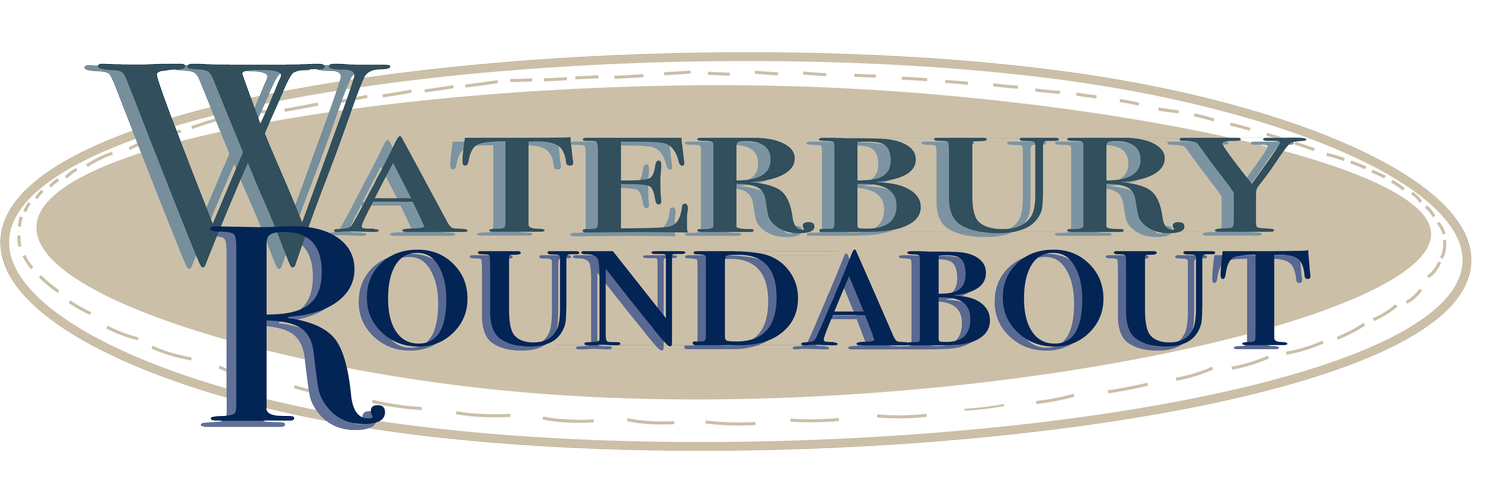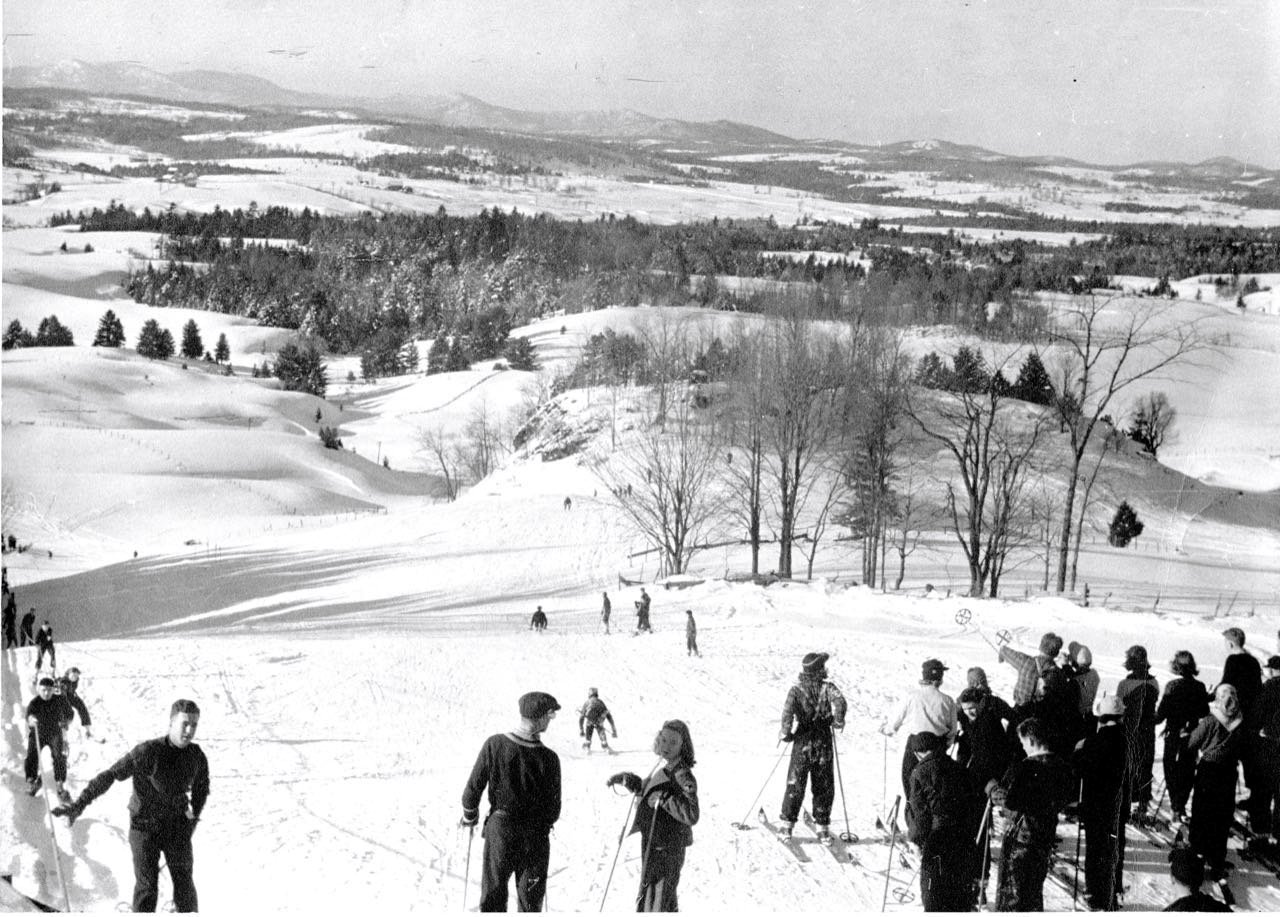Expanded exhibit, talks spotlight Vermont’s and local lost ski areas
January 10, 2025 | By Waterbury Roundabout Rolling snow-covered hills at the Barre Ski Club ski area in the 1940s, one of Barre’s five and 185 Vermont “lost” ski areas in the exhibit “Searching for Vermont’s Lost Ski Areas” at the Vermont Ski & Snowboard Museum in Stowe through Oct. 12. Photo courtesy of the Vermont Historical Society
Vermont’s lift-service skiing history began in 1934 with the installation of the first ski lift in the country: a rope tow powered by a Ford Model T engine on Gilbert’s Hill in Woodstock. A year later, the second rope tow in Vermont was built by Wesley Pope on Glenn Skiff’s farm in Jeffersonville. After that, small ski areas began popping up all around the state.
At one time there were five ski areas in both Waterbury and Stowe, two in Morrisville, and one each in Hyde Park, Johnson, Jeffersonville, and Cambridge. Over the decades, Vermont has lost 185 ski areas, leaving only 20 remaining today.
Click to enlarge map
The Vermont Ski and Snowboard Museum in Stowe has been documenting Vermont’s “lost” and “lost-and-found” ski areas for 25 years. The exhibit “Searching for Vermont’s Lost Ski Areas – Part 2” is a schuss down memory lane for those who learned to ski or ride at one of these slopes. In Part 2 of the exhibit (Part 1 opened last year), an additional 113 documented areas not featured earlier are introduced through photographs, interviews, newspaper clippings, and memorabilia from the museum’s collection. The full collection is now on view with all of the areas identified on an 8-foot-tall map including 20 ski areas still operating.
Among the lost areas highlighted in the exhibit are those that were located in Waterbury and Stowe. Another was right off Interstate 89’s eastbound Route 2 exit in South Burlington. Towns such as Newport, Middlebury, and Lyndonville had a strong ski-jumping tradition, which evolved into adding lifts for alpine skiing. Lifts and ski programs appeared at Norwich University, Johnson State College, Vermont Junior College in Montpelier, Sterling School, and Goddard College.
Farmers in Central Vermont and the Champlain Valley, seeking extra income during the winter, installed rope tows and strung lights for night skiing. Town recreation programs added lifts and offered lessons right in the middle of towns and villages. Inns and hotels rigged up lifts for their guests to enjoy. Many were community-based and locally run, while others were built with a vision similar to what ski areas look like today. Some areas lasted a season or two, while others lasted decades. Many closed due to rising insurance costs and stringent state lift safety protocols.
Two upcoming talks share local ski lore
Pinnacle Park Ski Hill was one of five lost ski areas located in Waterbury. Photo courtesy Waterbury Historical Society
Waterbury’s entries on the lost ski hill list will be featured in two upcoming talks, one at the ski and snowboard museum on Jan. 23, the other during Waterbury Winterfest on Jan. 30.
On Jan. 23, the Ski and Snowboard Museum’s monthly Red Bench series presents local historian Brian Lindner and exhibit curator Poppy Gall who will share the stories of 15 lost ski areas. These include one demolished during the construction of Interstate 89 and another that had to truck in snow from New York State during a snow drought. Audience members are encouraged to share their stories of long-forgotten ski areas from Waterbury to Morrisville to Cambridge.
The museum opens at 6 p.m. for this event with the talk starting at 6:30 p.m. Admission is $10, which supports the nonprofit museum's mission to “collect, preserve, and celebrate Vermont's rich skiing and snowboarding history.”
On Jan. 30, Lindner will share the Waterbury portion of the presentation during Waterbury Winterfest. Sponsored by the Waterbury Historical Society, this free event will be held in the Steele Community Room at the Waterbury municipal building, 5:30-6:30 p.m.
Aside from special events, the Vermont Ski and Snowboard Museum, located at 1 S. Main St. in Stowe, is open Thursday through Sunday, noon to 5 p.m. through the winter. The lost ski area exhibition is the work of volunteers with support from sponsors including Union Bank, Darn Tough, Winthrop H. Smith Jr. Charitable Foundation and Jeremy Davis of New England Lost Ski Areas Project. It will be on view through Oct. 12. To learn more about the exhibit or to share information about a Vermont lost ski area, visit online at vtssm.org.


